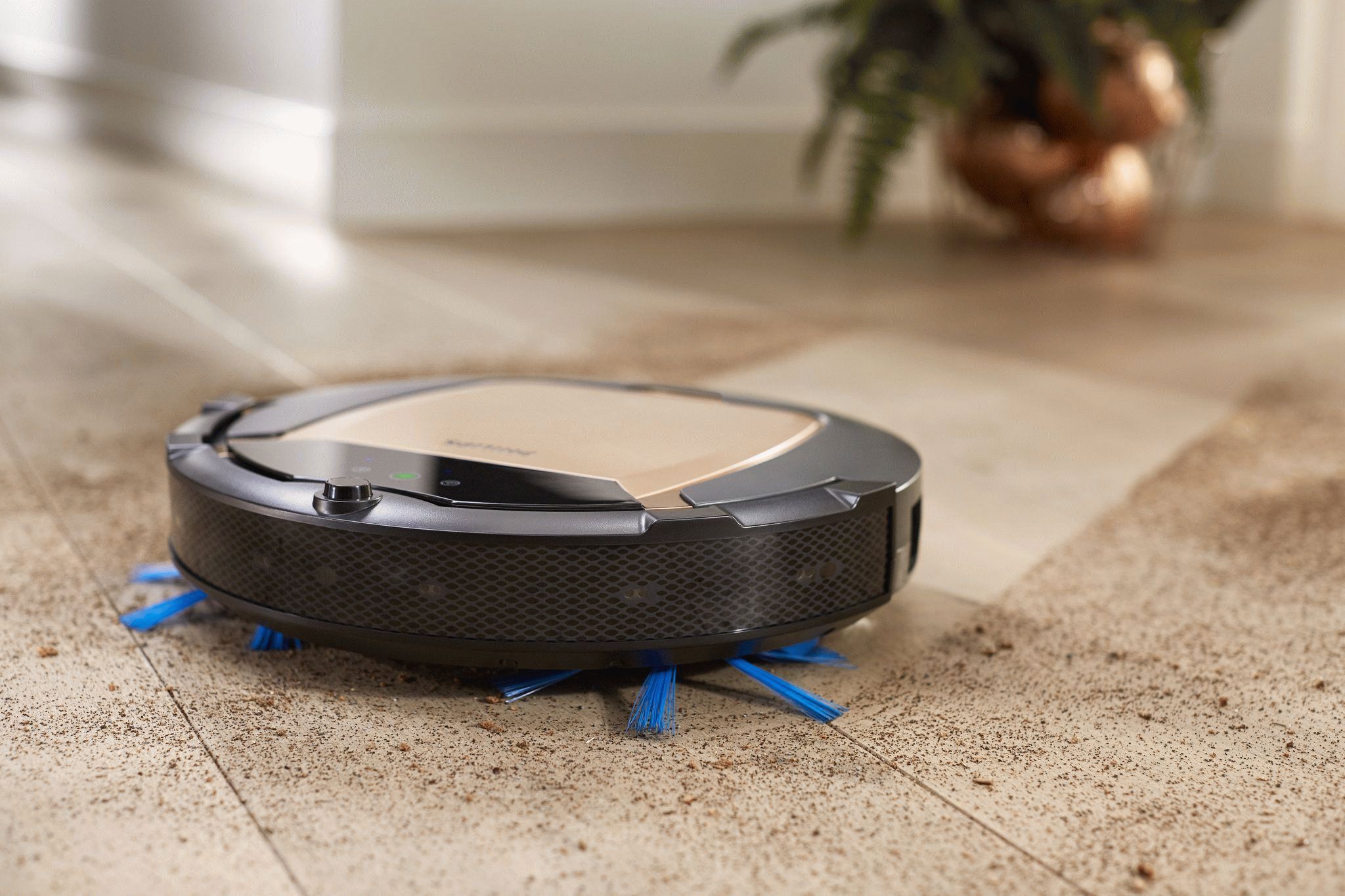Rating of the best ventilation deflectors for 2022

Ventilation systems are necessary to maintain a healthy indoor climate. In order for them to be useful, air circulation is necessary, but its strength is not always enough. And in such cases, it is recommended to install ventilation deflectors that increase air draft.
Content
What is a deflector
A deflector is an additional device, or rather a nozzle that is put on the outlet of the ventilation duct, which, under the influence of wind, creates a vacuum and thereby reduces the aerodynamic resistance of the flow of air masses at the outlet. In addition to creating additional traction, the device also:
- performs protective functions, does not allow precipitation to enter the duct channel;
- protects from wind, various debris, birds inside the pipe
- prevents the formation of reverse thrust and the accumulation of fat on the walls of the air duct system;
- the device also extinguishes sparks and removes smoke.
The basic principle of such a device is based on creating a vacuum and increasing the strength of air flows. Some manufacturers equip designs with electric fans.
Varieties of nozzles
there is a fairly large list of goods on the goods market, but they are all divided into several types:
- TsAGI, this type was developed at the Central Institute of Aerohydrodynamics and is one of the most common. The design is simple and consists of a metal tube with a shielding cylinder inside and a conical umbrella. It does not allow the draft to be locked in strong winds and protects the ventilation duct from clogging and precipitation. For full functioning, the structure must be placed above the roof at a height of 1 to 1.5 meters. Among the advantages of this cap, there is the possibility of replacing some steel parts with cheaper plastic ones. The disadvantages include covering in the winter period of time, the surface with a snow crust, which becomes an obstacle to normal air draft.
- Grigorovich's cap, a simple design consisting of a pair of umbrellas connected by a common "plate". Such structures can often be seen above the roofs of garages, basements of small buildings. But a more complex and refined model is Volpert-Grigorovich, which includes a diffuser, a reverse cone and a cover connected together.
- Turbo deflector or rotary turbine looks like a ball. Such a device works due to the rotation of the blades that make up the spherical part of the device. The draft is enhanced by the wind and the built-in fan. Such a device allows you to quickly refresh the air in the room, without the use of electricity;
- A weather vane is another type that has a complex structure, the wing of the device is always deployed with its back to the wind, which prevents spindle flows from entering the ventilation shaft. A zone with reduced pressure is formed behind the base of the nozzle, which facilitates the release of air;
- The H-shaped deflector has a more complex structure and consists of one horizontal and two pipes located at the edges. Horizontal and vertical resemble the letter "H". Such a device perfectly copes with increased traction and with protection from external debris and moisture, a cap that looks like a plate, the visor is attached to it with studs, creates an air flow, protecting ventilation from possible precipitation. This type is perfect for industrial and industrial premises, one of the features is that such models do not have a protective cap, since there is no need for it. And also a plus can be called the fact that such a design does not need to rise above the roof of the premises, it is enough to place one side on the wall and the other on the roof.
Devices are used depending on the design and are divided into:
- roof, that is, those that are used on chimneys in private and multi-storey buildings, on the roofs of industrial and garage premises, as well as other buildings;
- basement - designed to regulate air flow in the basement, refreshing the air, removing dampness and accumulated harmful gases;
- automobile, respectively, used in vehicles, the devices are designed to cut off the air flow, as well as to prevent the ingress of various objects, debris, dirt and much more that can fly from the street into the car interior, they are placed on the side of the side windows, the roof or above the headlights, form and dimensions will depend on the model of the vehicle;
- for air conditioners, special deflectors-screens have been developed that reflect the air flow and evenly distribute it throughout the room. There are internal and external.
As for the appearance of the nozzles, they are of several types:
- flat;
- semicircular;
- as well as duplex.
By type of design, exhaust hoods are also divided into several types. Fixed (static) are considered the simplest and are often made by hand. Static with a built-in fan located under the wind umbrella.
Material for manufacturing
Ventilation hoods differ not only in appearance, but also in the material from which they are made:
- Made of plastic, such devices are quite fragile and therefore are rarely found on store shelves;
- Made of metal coated with plastic, such models are more durable and have a rather attractive appearance;
- From metal intended for the manufacture of boilers, such devices are expensive, but they are highly resistant to burnout from exposure to hot air currents;
- From galvanized steel, products made from this metal are considered the most common because they have an affordable price and at the same time have good strength;
- Aluminum, also popular among manufacturers, has good strength and affordable price.
There are also caps made of copper, but they are too expensive and therefore this metal is practically not used for the manufacture of deflectors.
Selection features
The design of the caps is not complicated, but despite this, buyers should pay attention to such points:
- the material from which the deflector is made;
- How does it work;
- take into account all the features of the device.
The choice is also based on:
- in the presence of a small thrust or its complete absence, rotary nozzles or in the form of a weather vane should be chosen;
- when purchasing a rotating nozzle, you should know that inexpensive devices work using an open sleeve, which freezes in winter, it is recommended to pay attention to those that have a closed hinge;
- caps in the form of the letter H, perfect for areas in which there are strong winds.
Dynamic hoods are suitable for all types of terrain, but they must be serviced periodically.
Installation
The installation process is simple, but it should be remembered that not all actions are carried out directly on the roof, since the cap and the base of the device must be connected in advance, for convenience. So the installation is:
- from installing the device on the inlet couple and fixing it on it, this is done with special fasteners or bolts. In the second case, you will need to drill inlets for them;
- fixing the diffuser funnel with clamps or brackets;
- placement of the cap on the diffuser.
The last two steps are carried out before installing the device on the ventilation duct.
Experts in the field of installation of such structures recommend following some tips:
- The device is installed both on a straight line and on a pitched roof surface, chimneys and ventilation. The choice of location depends directly on the purpose for which it will be used.
- If the surface is pitched, then it is necessary to install at the highest point, on a flat surface, before installation, the possible height of the snow cover is taken into account and placed higher. It is recommended to set the level at least 18 cm.
- In order to avoid heat loss during the cold period, it is possible to install special dampers for residential premises and adjustable air intakes for non-residential facilities.
When installing the appliance on a chimney, remember that it automatically lengthens its height.
Rating of high-quality ventilation deflectors, popular among buyers
Various companies offer a huge selection of various types of deflectors, but users note the most successful models that they recommend for purchase:
Roof deflector/D 200 mm, galvanized steel
This model is produced by the Russian company Aeroblock, in addition to caps for ventilation systems, it produces filters, silencers, air valves and other products that are in great demand. The material from which the device is made is galvanized steel with a thickness of 0.5 mm. The cap consists of a base, which has the shape of a circle, a diffuser in the form of a cone with truncated edges and an umbrella.
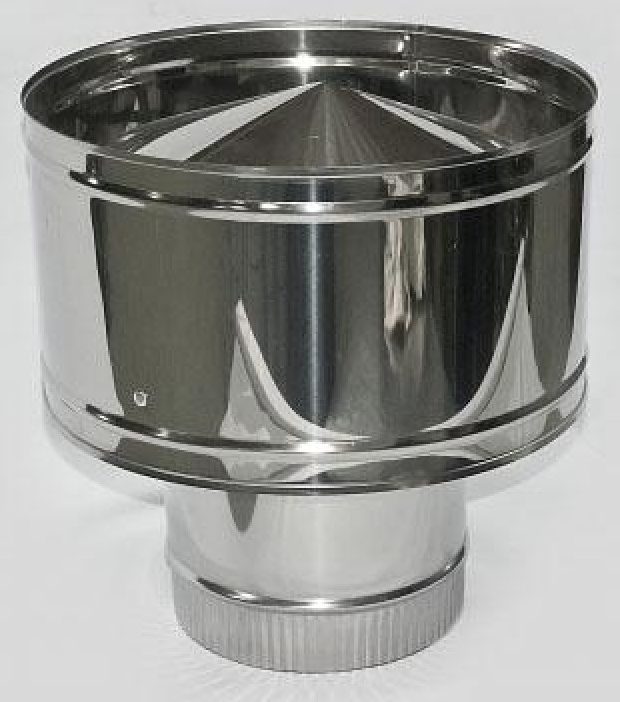
- increases traction force;
- protects from dirt and debris;
- the cap is made of corrosion-resistant material;
- universal;
- has thick walls;
- budget price.
- weight reaches 4 kg;
- not suitable for all ventilation outlets.
Ventilation outlet Wirplast/K88-2 uninsulated D125 brown
The Polish brand Wirplast is engaged in the manufacture of this hood model, which is suitable for installation in rooms, in kitchens and toilets, as well as in sewer shafts. The device is made of polypropylene, has a diameter of 12.5 and a height of 50 cm and is installed on a pitched roof surface.
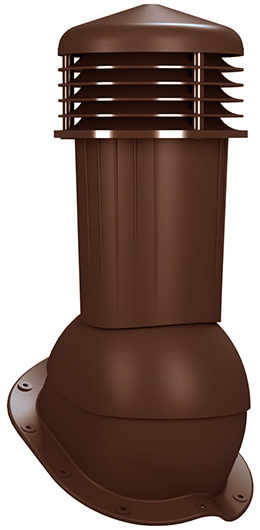
- product quality;
- stylish appearance;
- improves traction well.
- high price.
Base deflector / TechnoNIKOL
Socle deflectors of the TechnoNIKOL company are made of polyvinyl chloride, resistant to alkalis, acids, solvents. Depending on the additives in the manufacture, they can also have high resistance to fire, but are not intended for severe frosts. Suitable for use in all basements, that is, both residential and non-residential facilities.
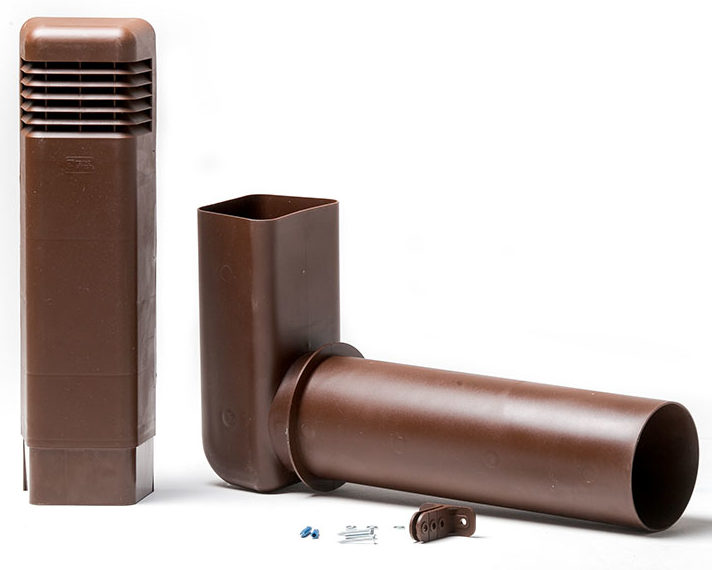
- stylish design;
- easy to install;
- perfectly copes with its functions;
- It is possible to adjust the length.
- the price is quite high compared to other models;
- has low frost resistance.
The best turbo deflectors
Turbo deflector galvanized metal, D 100 mm
Production Russia, the model is made of high-quality galvanized steel with a thickness of 0.45 mm, which makes it lightweight.Thus, the blades of the product rotate even with the slightest wind flow, increasing the natural draft in the ventilation tunnels by up to 20%. Due to the use of high-quality materials in the manufacture, the service life reaches 15 years. The design perfectly protects against the ingress of natural precipitation, debris into the ventilation.
- appearance;
- works effectively, no matter which way the wind blows;
- long period of operation;
- easy to install;
- works great even with big minuses on the street;
- additional energy is required to operate.
- the price is high.
Roof deflector/TD-150
The manufacturer of the turbo deflector TD-150 is Russia, the model is used on the roofs of residential premises, industries, garages, basements, toilets, the number of installed caps depends on the area of the object. The device is ideal as a smoke nozzle for chimney systems. The material used for manufacturing is galvanized or stainless steel. Thanks to the installation of a turbo deflector, the draft of the ventilation systems increases by up to 20%; in order to obtain a better operation of the device, it is recommended to install ventilation ducts located slightly at an angle on the pipes.
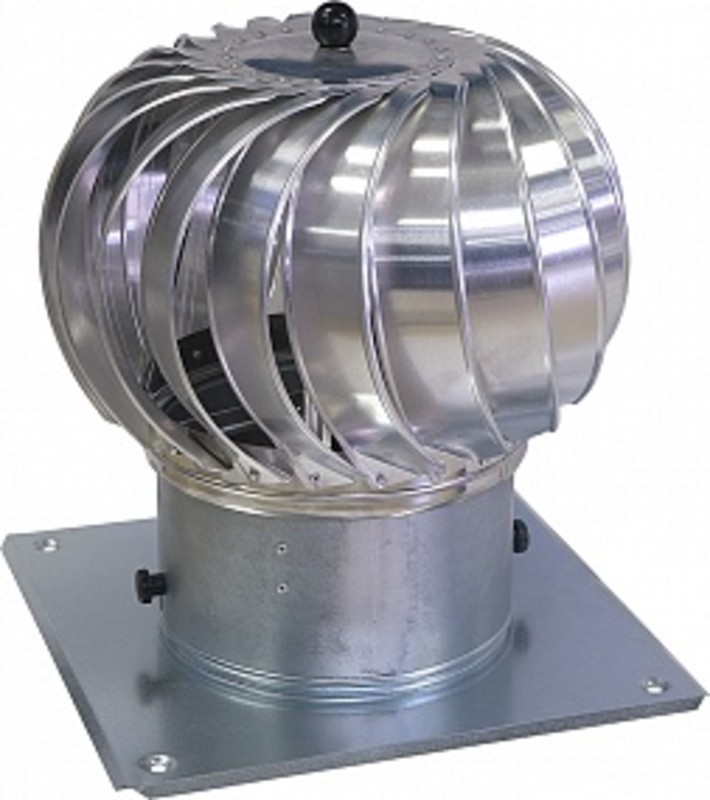
- the appearance of the device is quite nice;
- operates quietly but efficiently;
- the metal from which they are made;
- increase in traction by 20%;
- good protection of mines from various debris and precipitation.
- small dimensions;
- high price.
Turbo deflector, rotary ventilation turbine, D160, silver, plastic
The ventilation turbo deflector D160 is manufactured in Russia by the manufacturer Nanoturbo deflector.
The manufacturing material is ABS plastic. Its primary characteristics are resistance to atmospheric conditions, temperature changes, the ability to install even for regions with extreme weather conditions, UV stabilization. The material is also impact resistant.
The design is quite light, weighing just over 1 kg, while being quite balanced and durable. Special fastenings and numerous stiffening ribs are responsible for the latter.
The device is designed in such a way that moisture does not under any circumstances get on the bearings of the device.
Adjusting deflector diameter – 160 mm.
Cost: 2550 rubles.
- High performance;
- The turbine rotates smoothly;
- The device can be used even under harsh climatic conditions;
- Not afraid of falls, mechanical impact;
- High-quality bearings provide silent rotation.
- No, if you do not compare the strength characteristics of plastic and metal / steel.
Turbo deflector, galvanized metal, ERA TD-250 8017
An element of the exhaust structure connected to a round duct, the installation diameter is different, the larger it is, the higher the cost. The manufacturer is ERA.
This model can be purchased for 4400 rubles.

- Stylish appearance due to atypical coloring;
- Possibility of installation both for residential buildings, catering establishments, and at industrial enterprises, workshops, warehouses;
- Reliably closes the shaft from the ingress of foreign objects and dust from the outside.
- Not marked.
Deflectors of the device, which should not be neglected, because thanks to them the provided ventilation will cope with the tasks more efficiently. As a rule, the installation of devices is a simple matter, you can do it yourself or with the help of a specialist.
new entries
Categories
Useful
Popular Articles
-

Top ranking of the best and cheapest scooters up to 50cc in 2022
Views: 131651 -

Rating of the best soundproofing materials for an apartment in 2022
Views: 127690 -

Rating of cheap analogues of expensive medicines for flu and colds for 2022
Views: 124518 -

The best men's sneakers in 2022
Views: 124033 -

The Best Complex Vitamins in 2022
Views: 121939 -

Top ranking of the best smartwatches 2022 - price-quality ratio
Views: 114980 -

The best paint for gray hair - top rating 2022
Views: 113395 -

Ranking of the best wood paints for interior work in 2022
Views: 110318 -

Rating of the best spinning reels in 2022
Views: 105329 -

Ranking of the best sex dolls for men for 2022
Views: 104366 -

Ranking of the best action cameras from China in 2022
Views: 102215 -

The most effective calcium preparations for adults and children in 2022
Views: 102011



